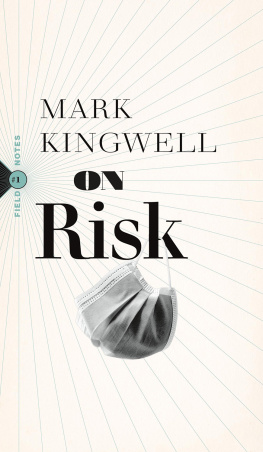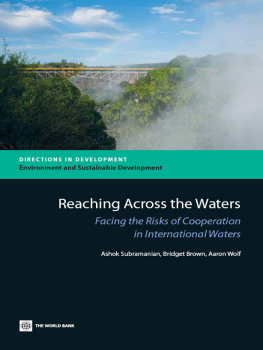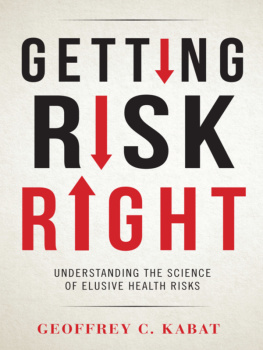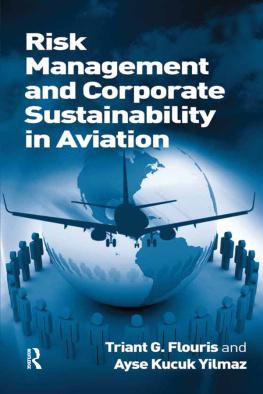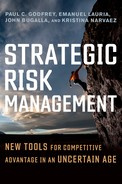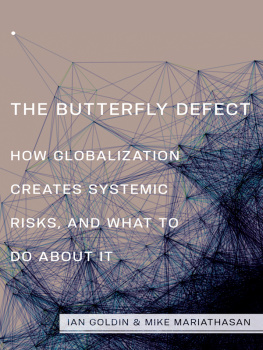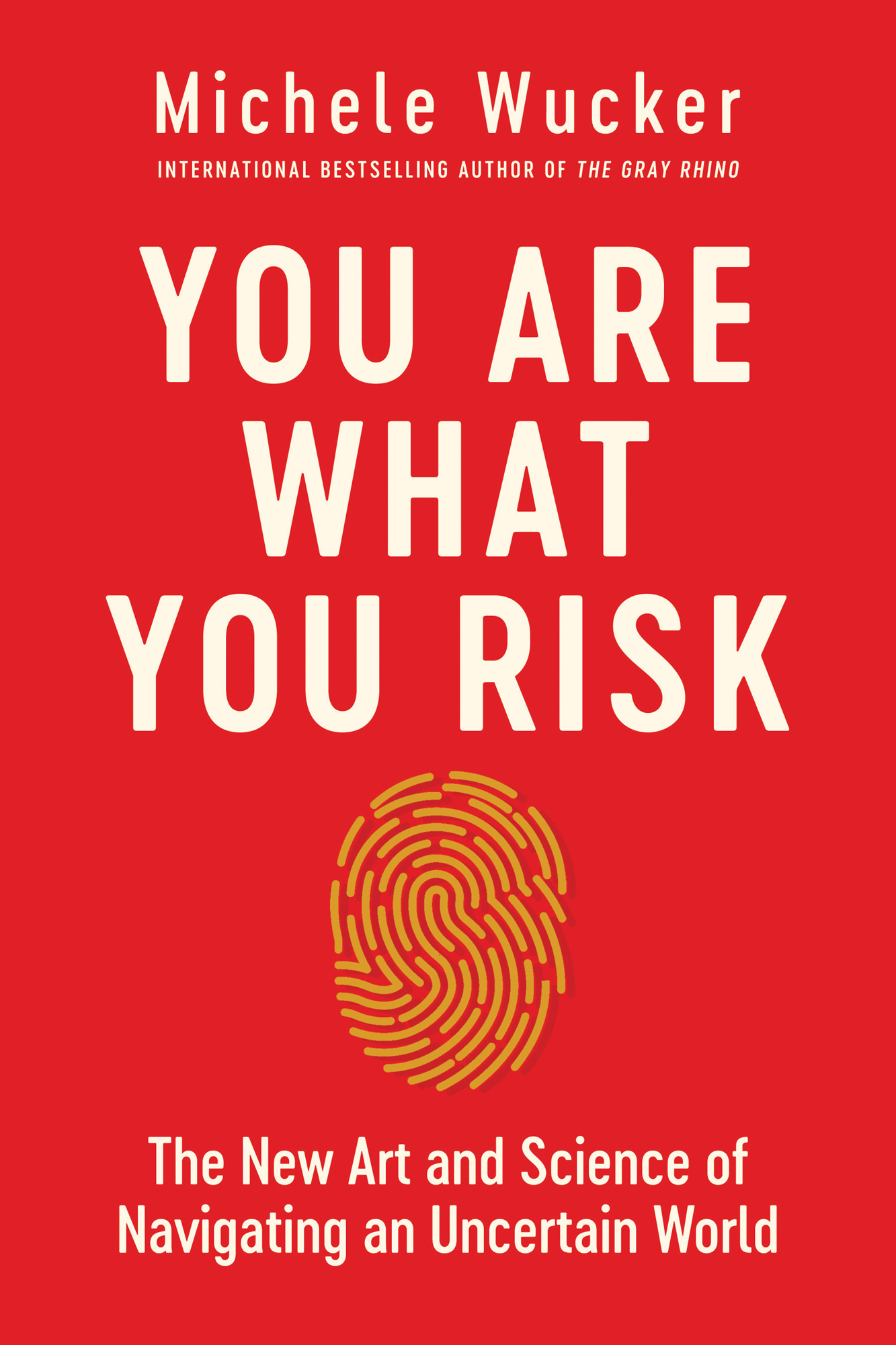Michele Wucker
International Bestselling Author of The Gray Rhino
You Are What You Risk
The New Art and Science of Navigating an Uncertain World
PREFACE
MY MATERNAL GRANDMOTHER was epic in her resistance to dealing with obvious health risks. Her doctors worried about an abdominal aneurysm that could have burst at any point. Normally, once an abdominal aneurysm grows to five centimeters, doctors believe the risks of operating are lower than those of leaving it in. Bobonnea Belgian nickname derived from the French bonnemre for grandmotherdidnt let them operate until it hit 6.3 centimeters. Even then, her adult children had to beg her to agree to the surgery.
Another time, my mother visited Bobonnes house after failing to get through on the phone. She found Bobonne, who was well into her eighties at this point, lying on the floor in pain after wrenching her back while trying to move a huge, old cathode-ray television set, having ignored the obviousness of this not being a good idea. Still, when my mother insisted on taking Bobonne to the hospital, she put up a fight. This was only one of many instances in which Bobonne avoided dealing with a medical issue until it escalated into a crisis. Her stubbornness became part of all of our memories of her.
Yet, despite her poor health risk skills, Bobonne was able to plan well in advancearguably too wellfor other possible dangers, namely the risk of going hungry. When she died in 2010, we found twenty pounds of butter in her freezer and another twenty pounds of sugar in her cabinets. It wasnt hard for me to understand Bobonnes hoarding of staples as a behavior learned from the food shortages in Belgium during the Second World War. Alongside the butter in the freezer were frozen vegetables harvested from her garden, a practice that made perfect sense.
I also could relate to her having actively decided to risk her life during the war as a teenager, when she delivered messages for the Resistance on her bicycle to keep the German occupation from becoming permanent. I tried to imagine what went through Bobonnes mind as she rode back and forth. Helping those fighting the Nazis no doubt was a way for her to feel some sense of agency, the power to make a difference no matter how small. In a time of great chaos and uncertainty, it was a risk worth taking. So was following to the United States the handsome, young, entrepreneurially minded American soldier who tried to start a popcorn business in Belgium after the war. Alas, the idea was far ahead of its time; Europeans still thought of corn as pig food.
The health risks she took by omission were harder for me to get my head around. Like her husband, she was a longtime smoker and alcoholic, ignoring the dangers that those habits posed even after my grandfather died far too young of a stroke. Perhaps the aneurysm represented something of a danger in the present and future that made her feel powerless; her decision not to deal with it, or with her wrenched back, was a perverse way to gain power over a situation. After all, surgery to control the threat involved becoming totally powerless under anesthesia, which made her completely dependent on the surgical team. In fact, like her reluctance to have surgery, many of the biggest and most common risks most people take are passive risks: putting off dealing with known problems for reasons that are a combination of innate human biases, individual hang-ups, and all kinds of outside roadblocks.
In the decade since Bobonne died peacefully in her sleepthe aneurysm had long been repairedthe contradictions of her life and relationship with risk kept raising questions for me. How could the same person be so practical, proactive, and courageous in their risk decisions and behaviors in some areas of their life but so obstinate and self-destructive in others? I wondered how much of the explanation lay in her innate personality, in her experiences, and in the nature of the risks themselves. I also saw how her failure to face her health risks affected her family, particularly my mother, who often had to rearrange her schedule first because Bobonne canceled doctors appointments, and then because the avoidable problems escalated to a crisis that forced my mother to drop what she was doing.
My paternal grandparents were the opposite, their house and later the apartment where they retired always in perfect order. When they died in their late nineties, just a few months apart, everything had been arranged, from the gravestones pre-chiseled with everything but their date of departure to the funeral menu (Swedish meatballs and ham). Their finances were all in order, unlike Bobonnes.
My parents each inherited many of their parents attitudes toward risk, uncertainty, and change. In hindsight, I can see how these differences explained their personalities, decisions, and conflicts over all sorts of issues, from seemingly mundane questions like how early to leave for church to other, more serious questions. Risk attitudes defined the family dynamic, both as individuals and as a group.
My own relationship with risk combines elements from both sides of the family. It evolved as I experienced new things, overcame new challenges, and learned new risk skills. By many peoples standards, I am a risk-taker. My risk choices, like everyones, are a mixed bag. I love trying new cuisines, but once I find something I like, I stick with it; I nearly always order the same thing at my favorite restaurants. I dont jaywalk. I watch my diet; having been diagnosed with celiac disease in 2011, I have no choice but to avoid anything containing gluten or I get very sick. I dont smoke. I exercise and get my annual medical checkups like clockwork. But my behavior and preferences over the years have changed along with my relationship with risk.
As Ive gained more insight into how intimately risk lies at the very core of our identities, its become apparent both how short most of us fall in thinking about it and how much opportunity lies in taking the time to look at our thoughts and behaviors through a risk lens. Reflecting on the way people deal (or dont) with risk has generated a slew of other questions not just about Bobonne but about all of us and the role that our relationships with risk play in the decisions we make. Which risks are worth taking? How good are you and others around you at recognizing risks and assessing their importance? Do you treat active risk-takingsay, bungee-jumping or day tradingdifferently from passive risk-takinglike putting off going to the doctor or doing your taxes?
Why do some of us fixate on reducing risks while others crumble in the face of possible failure? Why do some people avoid risk after major shocks, while for others the experience of facing down and conquering risk leads them to add more risks as it helps them to manage those risks better? How much of your risk personality is innate and how much derived from your experiences? How much is nature and how much nurture? Can we train ourselves to act differently in the face of known risks? What prompts us to change our risk behavior, and how do we make those changes stick? What obstacles must we overcome to achieve a healthy risk relationship? The answers to these questions are the reasons I wrote this book. Together, well explore questions about what each of us is prepared to risk and how that defines and reflects our purpose, passions, priorities, and values: the very core of our being.
By thinking about your own relationship with risk and that of the people around you, you will learn more about what makes you who you are as an individual. You will come to better understand your organizations values, culture, strengths, and weaknesses when it comes to risk, innovation, and strategy. You will think differently about how the risk dynamics in your community, country, and the world shape the choices available to you.



